#AR game Development solutions
Explore tagged Tumblr posts
Text
Elevanco provides affordable UI/UX design services for startups, helping create intuitive and visually appealing digital products on a budget. Our expert team focuses on improving user engagement, increasing conversions, and building brand trust. Whether it's a website or mobile app, we offer scalable, cost-effective solutions tailored to your startup's needs. Contact us at +91-7388885426 today!
#Affordable UI/UX design services for startups#game development services in delhi#Custom game development solutions for startups#Top mobile game development companies near me#Game development services for educational apps#End-to-end game design and development solutions#Mobile Game Development Service#3D Game Development Service in delhi#2D Game Development#AR/VR Game Development#professional game developers for my project#Best game design and development solutions#Best game development tools for creating 3D games
0 notes
Text
Are you ready to experience the future of immersive technology? KPIS Pvt. Ltd. is a leading AR and VR App Development Company in India. We specialize in creating immersive and interactive experiences using Augmented Reality (AR) and Virtual Reality (VR) technologies. Our team of skilled developers, designers, and innovators builds cutting-edge apps for industries ranging from gaming and entertainment to healthcare, education, real estate, and retail.

We deliver custom AR/VR solutions tailored to meet the specific needs of your business, whether it's creating realistic virtual environments, interactive training simulations, or immersive shopping experiences. With a focus on user engagement, scalability, and innovation, KPIS is committed to pushing the boundaries of what’s possible in AR/VR technology.
Partner with KPIS Pvt. Ltd. to take your business into the future with next-level AR and VR experiences that captivate and engage users like never before.
#AR App Development Company#VRAppDevelopmentCompany#AugmentedRealityAppDevelopment#Augmented Reality (AR) and Virtual Reality (VR)#augmented reality agency#virtual reality (vr)#augmented reality solutions#game development company#game development#AR Mobile App#VR Mobile App#Future of VR#VR Education App
0 notes
Text
2024's Game-Changing Technologies for Metaverse Development

Picture a universe where virtual and physical worlds blend seamlessly, allowing you to interact with digital elements in real-time. As 2024 draws near, groundbreaking technologies are shaping this metaverse, making such interactions more immersive and dynamic than ever.
The metaverse, an expansive network of virtual environments, is evolving rapidly as we approach 2024, driven by several key technologies. Virtual Reality (VR) and Augmented Reality (AR) are at the forefront, enabling immersive experiences that blend the physical and digital worlds. VR technology has advanced significantly, offering users enhanced graphics, realistic simulations, and responsive feedback that create fully immersive digital environments.
AR enhances the physical world by overlaying digital information, enriching experiences in retail, healthcare, and entertainment through interactive and engaging environments.
Blockchain technology is essential for the metaverse, providing a secure and transparent method for managing digital assets and transactions. Non-fungible tokens (NFTs) allow users to own unique digital assets like virtual real estate and art, while smart contracts facilitate automated and secure transactions. The decentralized nature of blockchain promotes trust and reliability, making it a crucial component of the metaverse's infrastructure.
Artificial Intelligence (AI) further enhances user experiences by creating intelligent virtual agents, personalized interactions, and realistic simulations. AI-driven non-player characters (NPCs) provide engaging and adaptive experiences, and AI technologies enable natural language processing and speech recognition for seamless communication between users and virtual environments.
Edge computing and 5G technology are critical for the seamless operation of the metaverse. By bringing data processing closer to users, edge computing reduces latency and improves the responsiveness of virtual environments. 5G networks provide the high-speed internet required for real-time interactions, supporting scalable and complex virtual environments.
The Internet of Things (IoT) and spatial computing further enhance the metaverse by capturing physical movements and translating them into virtual actions, creating realistic and immersive experiences.
Elevate your business with Intelisync's cutting-edge metaverse solutions. Reach out to Intelisync today and learn how our advanced technologies in VR, AR, AI, and blockchain can revolutionize your operations, enhance customer engagement, and drive your Learn more...
#AI-driven NPCs#AR/VR for interactive product experiences#Artificial Intelligence (AI)#Augmented Reality (AR)#Blockchain#blockchain for secure transactions#Blockchain Technology#Edge Computing and 5G Technology#How Intelisync Uses this Technology for Growing Client Business#Increase in Engagement#Intelisync’s Metaverse Solution for Retail Business#Internet of Things (IoT) and Spatial Computing#IoT devices#Market Expansion#Metaverse Development#Metaverse development company#metaverse game development#Operational Efficiency#Personalization with AI#Sales Growth#Secure Transactions with Blockchain#smart contracts#social VR platforms and games.#Top 5 Technologies for Metaverse Development in 2024#Virtual Reality (VR)#Virtual Reality (VR) and Augmented Reality (AR)#Virtual Showroom#What is the Metaverse?
0 notes
Text
Game Development Company in Singapore- Mobiloitte
Mobiloitte, a Singapore game development company, excels in delivering top-notch game development services and solutions, including AR/VR game development. With our expertise, we bring immersive gaming experiences to life, blending creativity and technology seamlessly. Elevate your gaming venture with Mobiloitte's exceptional game development services and unlock the potential of augmented and virtual reality gaming.
#game development company#game development solutions#game development services#mobile game development company#nft game development services#play to earn game development#play-to-earn games development#cross platform mobile game development#play to earn game development company#AR / VR Game Development
0 notes
Text
Here's my personal interpretation of Faust's character development from Xrd to Strive because I love to ramble about tall doctors in embarrassing length. Only open the "Keep reading" if you are feeling insane enough for my silly fictional brain rot.
I'm writing this as somebody who used to struggle with depression and relates to him in this way. I see his mental state represented through his visual design but overall I interpret him to be doing better mentally in Strive than in any of the earlier games, even if it might seem counterintuitive looking at his current state.



First, I'll talk about the events in "Another Story". Here, Ramlethal tells him to not use her or the entire Delilah rescue mission as a tool for his personal atonement. Something that makes him genuinely pause and think. This rarely happens with him. Her input leads to his "Square One" quote that he keeps repeating while channelling the giant portal door.
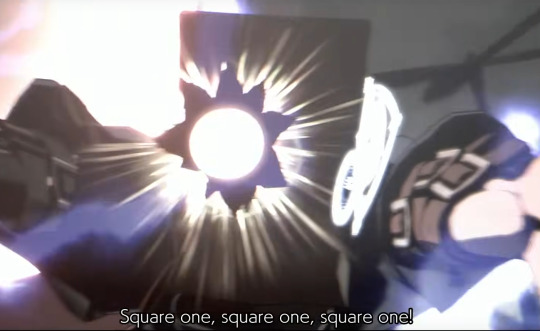
I interpret this as him taking Ram's advice and focusing on what his original (square one) motivation for being a doctor was: Saving lives (as he clarifies in his arcade mode). He had been so consumed by his guilt that he made it his first priority to atone for his sins, instead of acting out of the intrinsic wish to help others.


This change of priority is what I see as the reason he doesn't overexert himself through the magic he is casting to a degree that would kill him in the process. No, just like Ram told him to, he is taking care of his own life too, surviving in the end. Even though he was fully prepared to sacrifice himself prior to Ram talking to him.
In the process he turns into his skinny, sickly, scary looking Strive self with the ominously red glowing eye. I interpret this as him for the first time since picking up his Faust persona to drop the facade and be real with himself. Allowing himself to show weakness and sadness.
In his Xrd win quote against Elphelt he says "Lies can become truths. I still find those words difficult to understand. I only hope that the smile you wear is not merely a mask like mine." The silly, cheerful Faust is an act he is playing. Behind the mask, he had always carried the sad face of Strive Faust. He was just hiding it very well during Accent Core and Xrd.
The fact that it is an act is nothing negative, though. We ar all actors to a degree. The Faust role he is playing is what gave him the strength to move on from being Dr. Baldhead and his kindness is always genuine. The mask metaphor is of course visualized through his paper bag that he clings to so desperately, it seems to give him more of a sense of identity than his actual human face.
The character development that Ram caused in him is further touched upon in his arcade mode story. When Ram asks him, "Who is going to save you?" He answers, "I, save me. Finally found, my answer." After all this time, he is able to start finding the solution to his grief within himself instead of trying to externalize it. While his previous cope was to hyperfocus on redeeming himself by helping others at any cost even if it would harm himself, he is now at a point where he can reflect on himself and see that he can help others and himself better if he forgives himself internally.
Towards Nagoriyuki he also says "It's okay, to ask for help." This is a big step for Faust since he acts very lone-wolfish and purposefully unapproachable through the entirety of ACR and Xrd. Being silly and friendly on a surface level, but never letting any real vulnerability show or building deeper bonds towards other characters, always sticking with his mysterious wandering doctor schtick.
The use of his flowers and Mini Fausts is interesting to me too.


It is implied that his flowers partly grow as involuntary emotional reactions as seen in his idle crouch fidget animation where the flower grows on his butt against his will and his reaction to Stimulating Fists of Annihilation 😅... So we can assume they are at least in part a representation of his emotions and how he handles them.
During the Accent Core and Xrd era he used his flowers as weapons. In Strive he only uses them in his respect and crouch fidget animations and doesn't cause damage with them, which leads me to believe he is more in peace with himself and his emotions.



Now if we look at the flower designs in comparison even though the flowers used to have brighter, happier colours they used to look straight up terrifying in ACR, not specifically happy in Xrd and even though they are creepy in Strive, they smile and seem happy.
The Mini Faust design in Strive is more on the creepy side too in comparison with the earlier versions, but if we look at how he actually interacts with them in game now, there is a lot more care and appreciation. Prior to Strive, I don't know of any Mini Faust appearances outside the "What Could This Be?" attack. In Strive, however, they show up in his respect animation, in his "Bone-Crushing Excitement" reaction and in his timeout animation, where the Faustlings and him act very sweet and caring towards each other (like the Mini Faust pulling his soul back into his body).
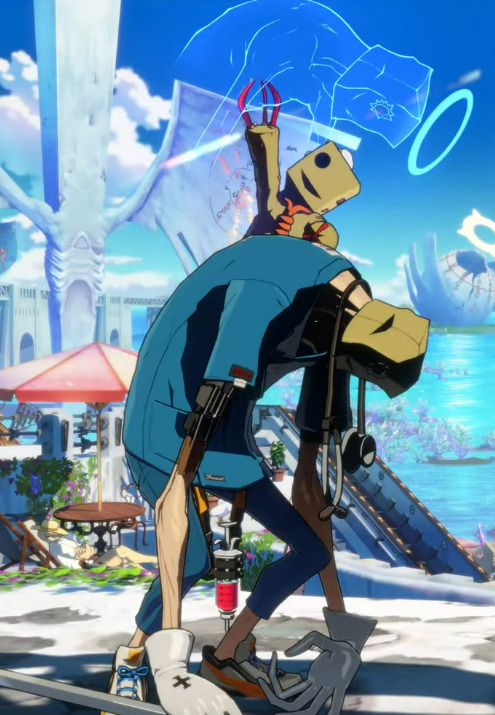

So to conclude, like with his flowers and Mini Fausts, his dark change in visual design reads to me as him being able to show more of his true inner world to the outside, opening up and allowing himself to show weakness as a step towards inner healing. It may not be a pretty truth to look at, but he's being honest to himself. And even through the obvious sadness and grief that is expressed in his Strive design, he is still so full of whimsy and silliness in his animations and interactions with others. He makes jokes, he goofs around, he shows joy for the little things like clovers/doughnuts/etc., and he chuckles a lot more during combat than before too. His way of talking is more calm and at peace with himself, instead of the overly energetic way he used to act. He used to seem like he was always on edge, running from himself and running to do more to atone for his sins.
In Alone Infection, the last repetition of the chorus has "blue, red and black paranoia" replaced with "joy, grief, fun paranoia". I think it's a beautiful message that we are allowed as people to exist in grief, let it happen and feel it truly while still feeling joy and fun. Like Faust, we are complex beings with lots of emotions, and we don't need to always act out the happiest, strongest version of ourselves. He is working through his sadness and that's okay.
29 notes
·
View notes
Text
The facts about Vanessa’s history prior to Security Breach. (And a summary of the different companies involved in AR and HW.)
I won’t lie, this (hopefully!) effortpost was prompted by watching Dual Processes latest video about Vanessa, where they state that ‘In AR, Vanessa pretends to be an IT Rep to trick Silver Parasol Games into giving her full access to the game.’ Which was… interesting, to me. Because it showed Vanessa’s email to Steve Wilson, who works for Anna Kwemto, who works for…
We don’t actually know the company she, or her underlings, work for.
Anyway, this isn’t made to target any specific people- Dual Processes’s video about Vanessa is brilliant (no spoilers- go watch it!) despite my quibbles at the very start. And the corporate chains in HW and AR, are confusing and easily mistaken- to the point the fnaf wikia has a lot of errors I needed to shift through while researching this topic…
I’ll lay all my chips on the table straight up- I had to find out a lot of Vanessa's backstory just before Ruin released, because I wasn’t really following fnaf until after Ruin was announced. I’d dipped around the HW days.
But I’d noticed a fair bit that, because few people played AR, and even those who did play AR likely didn’t see all the emails, that there are a lot of assumptions about who works for who, and who does what. False info that led me into believing a lot of misleading information about Vanessa before I looked into it more.
This misinfo even goes as far back as HW- do you think Vanessa works for Silver Parasol Games in HW? It’s a common belief- but I think it’s a misconception. And I’ve brought proof to the table.
Anyway, the point of this is to lay out anything about who works for who, and where they work. Because corporate chains are complicated, in a series that is already complicated enough!
First things first, what companies are we dealing with?
Well, there’s Silver Parasol Games. Which gets shut down and brought out during HW’s development. (Tape Girls Tapes- 1, 10, 15) I’m not gonna try to put years of operation because… no. But I do need to make it clear it shuts down prior to Vanessa beta testing the game.
People working at this company named in HW include Dale, Jeremy, and Tape Girl. If you go off the scrapped fake website for Silver Parasol Games, then the company also includes Gabriella, Tonya, and Aiden. (One of the two girls is likely Tape Girl.)
There is also Another Potential Development Studio, which is unnamed but suggested to be buying out Silver Parasol Games. (Tapes 10, 15). We don’t know much about this company other than Vanessa must work here during HW. [She never mentions a boss, or coworkers with this company.]
For AR, there is Anna Kwemto’s company, which is a subcontractor working for Fazbear Entertainment. It goes unnamed in AR.
The people working at this company include Anna Kwemto, Daniel Rocha, Raha Salib, Steve Wilson, and Mark Cho.
DLZ Shipping Solutions- a company that shipped animatronics parts to… they don’t say which company. But we at least know which person- Lisa Jameson (regional director of logistics for an unknown company.)
Their employees include Jimmy Hauss, (before getting fired) and James Strand.
Fazbear Entertainment- has a variety of teams and job positions. I’ll try to list them all here, though not in order of operation sorry. Kayla Stringer- Legal. Vanessa A- Security. Luis Cabrera- IT. Shonda Ford- legal. Greg Abernathy- IT. Dan Ximenez- IT. Jerome Khan- Accounting. James Campbell- IT. Todd C- Office Staff. Aiden Jackson- IT. Ivan Gagarin- Accounting. Diannah Larimore- Marketing (laid off). Maria A- Marketing (laid off.). Cheryl M- Office Staff. Anand G- Legal.
All from here on out have unknown job roles- Kenneth Freeman, Christie Buckley, Ben Pulley, Karen Soto, Brenda Tanaka, Stanley Howser, Jack Sims, Jay Murphy, Charles Ramirez. Jim Campbell.
There are also basic login details from some unknown people, from another unnamed company in ‘Security Incident Log- September.’ They are J_B and A_L.
There are also more workers who don’t have a specific company they’re tied to- but are working with the Funtime Service. These include Nora- R&D. Tristan- Compliance. Charles- QA. Isolde- Customer Service.
Okay. So that’s the raw data. Kowalski- analysis!
Jim and James Campbell are… interesting. They could be brothers. They could just have the same last name. They could just be a mistake- someone misspelling a name and accidentally making two characters where there should be one.
Honestly, I’m assuming it’s a mistake. AR was being made in that timeframe where Scott was pretty hands off about the story, and barely communicating with Steel Wool about SB. This is likely just a mistake that no one cared enough about enough to notice or correct. Like Luis being in IT in AR, then in Marketing in SB. Without any foreshadowing that he was transferring.
I wish they’d clarified which company Lisa Jameson, Nora, Tristan, Charles and Isolde worked for- or if they worked together, even. It sounds like they all work with the funtime service, based on the emails. But I can’t be sure of it, because none of the Nora/Tristan/Isolde/Charles emails reference Lisa, and vise versa.
*sighs*
It’d be useful to know if they work for Anna Kwemto’s company, Fazbear Entertainment, or somewhere else entirely. Because that’s the key to figuring out whether Anna Kwemto’s lot were scanning circuit boards for game development (unlikely for the timeline- but as said in the Jim and James rant- Scott wasn’t communicating with his teams. And its unlikely Steel Wool was communicating with Illumix either.) Or whether they were scanning circuit boards to recreate animatronics for the funtime service.
If Lisa was working for Anna- then it’s fairly cut and dry. They’re working in a warehouse storing animatronics, with an office attached for more hands-off staff.
If Lisa was working for Fazbear Entertainment in-house, then that leaves the possibility that Anna Kwemto’s lot weren’t running the Funtime Service. (Since Lisa’s emails imply her warehouse has ‘active animatronics’ too- including Bonnie eating a cat… which… I could’ve done without knowing thanks game.) And the Nora/etc emails explicitely talks about the new animatronics being sent out with the Funtime Service.
Also, sucks not knowing for sure who and where from J_B and A_L are. I’m assuming that they’re unnamed people from Fazbear Entertainment’s IT department- considering when Vanessa hijacks herself an IT email address, it has the same layout (V_A). But it’s not confirmed and no one with these initials is written as working for Fazbear. (Unless I missed something- please let me know!)
With Anna Kwemto’s company- it scans circuit boards of animatronics, which is why people might confuse them with Silver Parasol Games. However, they are never stated to be involved in game development. And by the time Vanessa has left Another Potential Development Studio to join Fazbear Entertainment, Silver Parasol Games should no longer exist as a separate entity. (Considering it was going to be bought out by Another Potential Development Studio while Vanessa was working there.) Timeline-wise, Anna Kwemto being the head of Silver Parasol Games doesn’t add up. And circuit boards could be scanned for a variety of reasons- say, if you’re making replicas of old animatronics for the funtime service.
(But that’s getting into speculation- while it’s implied they’re a subcontractor running the Funtime Service for Fazbear in the emails, there’s no explicit proof. Only the email from Raha Salib to the rest of the crew talking about an unknown user giving commands to all ‘active animatronics’ really gives us a hint to them running the Funtime Service. And that doesn’t neccesarily mean active animatronics are from the Funtime Service.)
‘Where are you getting a timeline from Summerly?’ from the games.
Vanessa gets infected by Glitchtrap, because circuit boards are sent to Silver Parasol Games and scanned into the Freddy Fazbear Virtual Experience. (The in universe VR game Vanessa’s working on) Vanessa can’t start being possessed by Vanny and acting weird around Luis before she get’s possessed- so HW must happen before the storyline events of AR.
During the story of AR, Vanessa (most likely Vanny puppeting her) locks out all of Anna’s workers, including Anna, after they scan some circuit boards and got a virus. Because they’ve been locked out, all ‘active animatronics’ become impossible to control. Around this time, either Vanny or GGY sends out a data package using a new account- ‘_pizzaplex’ that presumably 1. Targets the pizzaplex currently in the process of either being built or operating, and 2. Infects the animatronics there.
(Again- Scott was hands off during this time. I know this contradicts The Storyteller.)
If it was any other way around, Vanessa wouldn’t be infected with Glitchtrap during AR. She’d just be… being extremely weird for no good reason. Doesn’t make sense storywise.
Ultimately, these random companies and workers aren’t important except for acting as reference points- who works where and whos coworkers with who?
The important part is Vanessa. And this post does have something to say about Vanessa. Mainly, what I’ve already included- no, she did not work for Silver Parasol Games. But also something I had falsely believed prior to doing this research- she didn’t work at Fazbear Entertainment before working as a security guard there during AR, either. Or at least, that’s never proven. She works for the company that buys out Silver Parasol Games. Then probably job hops between games, to get into a position that is more useful for Glitchtrap. A position at Fazbear Entertainment.
It’s never explicitly stated that Vanessa (or Vanny) is sending the tutorial emails to customers of the funtime service. But considering the focus on collecting remnant, the sender being ‘FAZ//...AR ENT##AIN_!MENT’, and the repetitions of ‘funFUNFUNfun’ and similar throughout those emails… It’s likely Vanny is sending out those emails after hijacking the funtime service animatronics. (Which would explain why she wanted to work at FazEnt, and why she locked out Anna Kwemto’s lot if they were running the Funtime Service animatronics for FazEnt.) Basically, in order to control the animatronics, she needed to control the subcontractor (s) and have a position in FazEnt to exploit.
Why did she want to control the animatronics? Remnant, probably. The modified emails sent from ‘FAZ//...AR ENT##AIN_!MENT talk about collecting remnant. And some of the animatronics sent out through the Funtime Service emulate the Funtime Animatronics… like Funtime Freddy and Circus Baby. Who would have stomach hatches, if whoever replicated them didn’t think too hard about what they were building.
Basically, Vanny needed remnant. Possibly for rebuilding Afton. Possibly for fixing the Mimic. She could risk herself getting remnant personally… or she could get some machines to do it for her. These machines would also be useful for, say, disposing of some meddling therapists at a later date.
This may even explain what the scooper's there for in Ruin. Vanny may have been using the scooper on the Funtime Service rentals to receive their remnant after they killed someone.
Anyway, that’s all I got for now.
#five nights at freddy's#fnaf vanessa#summerly talks#sorry for the long one but this topic has been running around in my head for a while and I FINALLY decided to do the work for it today
21 notes
·
View notes
Note
I hate how Mephistopheles has no lore. I'm making an OC that out ranks him and the fucker has no established rank??? Sir your whole goddamn thing is "I'm a noble, goddamn it" and like no rank? No bitches? No nobility??
So I'm picking one (Grand Dutches, technically?) and going with the punches, but how do you fix Solomare's near non-existent lore so well?? This shit is hard! Mad props!

I'm grateful that we got more Mephisto lore in Nightbringer, but like many characters, new info or interactions are few and far between except when it's needed as a plot device. lol
Even though Mephisto isn't a member of the Ars Goetia, he's a Faustian demon or what I call a "named" demon which has important relevance in my personal world building. Other than that, we know that his family has deep roots to the Devildom nobility, are highly influential, and that he was basically raised to be Diavolo's friend. We know his special power now thanks to Nightbringer, but my version of it is a bit sinister because, you know, demons.
Unless you're new around here, my solution to gaps in the game's lore or storytelling is solved by personal headcanons/world building and creating OCs. I knew I wanted to write more about Mephisto, and that meant exploring his relationships and history outside of what the game told us.
Before NB existed, I was already developing his little brother OC because using characters/info only found in the games limits the potential for complexity and drama. Plus, writing an OC for Mephisto's brother helped me develop my own interpretation of Mephisto's character too.
When the game only leaves us crumbs to work with, here's what my brainstorming looks like to try and explore possible ways to fill in the gaps:

Creating an OC for Mephisto's younger brother: Mephisto is a named demon and part of the demon nobility. My thought: his brother is probably a named demon of some importance too.
Naming Mephisto's little brother: After doing some reading, I learned Mephisto wasn't part of the Ars Goetia, but that didn't mean his brother couldn't be. Result: I just picked a name off the list that I liked. LOL
Note: I have friends that have OCs based off other Ars Goetia demons so I purposefully avoided choosing those names because I write about my version the Devildom assuming those OCs exist within it.
Developing Bathin as an OC: Okay, we have a name. Cool, that's usually the hard part. Now we have to build him up from nearly nothing! What I knew about his character before NB released: he was significantly younger than Mephisto (I imagined the same or slightly younger than Luke with a similar childlike appearance) and that Mephisto was a very attentive and doting older sibling. Based on the RAD Sports event in OG, I concluded if he was that protective of Luke, he would be even more protective of his younger brother as well. I also interpreted the events and assigned Mephisto his demonic trait (having a tail of some kind instead of wings). In my mind, demonic traits are something that might be part of the family's heritage, so I decided that Bathin would look similar to Mephisto in his human form and also his demon form.
Identifying gaps/issues with Bathin's character: The main concern I had to address for Bathin was his existence as a demon of the Ars Goetia. Solomon has pacts with all of them, and this implies that he would also have a pact with Bathin - a literal demon child. Oops!
Questions I needed to answer:
Why would Solomon want a pact with a child and how did this happen?
Are there any limitations/restrictions if a pact is made with a demon child that isn't mature/"of age"?
Should I change his name to something else to avoid this issue? Nah.
Solving Bathin's existence as a child in the Ars Goetia: I basically wrote a world building theory about demon death/exorcism and respawn cycles to explain which demons can respawn and which ones cannot. Naming conventions and the impact on existing pacts are part of this theory.
Conclusion using fill-in-the-gaps world building:
A form of the death & rebirth cycle exists for demons.
Using theory, Bathin can exist as a member of the Ars Goetia because he was killed/exorcised as a mature demon. His essence/power exists within the version of him that was reborn later.
Implications and things to continue developing:
Bathin made his pact with Solomon as a mature demon and the pact persisted through death, although as a child the pact is weak and practically unusable.
Demons who respawn usually have no memories of their previous existence, but Mephisto would remember him from before. That can explain why he might be close and very protective of his younger brother. Solomon would also have memories of past!Bathin as well and that could have some interesting effects on how Solomon interacts with Mephisto as well.
Demons that are exorcised and respawned might carry some lingering physical evidence of their death - for example, the power of an angel's grace maiming some part of their body. This helped me visualize Bathin's physical appearance and explain any potential scars or flaws he was born with.
Child!Bathin won't be a copy of his former self, so there is potential for drama/angst as those that knew him best before re-learn the "new" him.
The possibility to explore Mephisto as a child and how his friendship with Diavolo was fostered/pressured by those around him (and Bathin's feelings/attitudes about Mephisto's potential (mis)treatment).
Explaining past!Bathin's untimely demise in the first place and the characters/circumstances involved.
If you ever wondered how I take a random throwaway reference in the game and expand on it to create an OC, here's what the process looked like when I was developing Mephisto's brother. He's very precious and though I doubt we'll see much more of him in the game other than some vague references, I enjoy writing about Mephisto enough that dedicating an OC to his little brother was worthwhile.
I'll end this with a treat for those of you that decided to read through all this rambling:

#if anyone wondered how I come up with ideas for ocs its your lucky day#this got a little long oops#jes.replies#jes.world building#my oc: bathin#the lil bit of art at the end is by vitaminnin on twt
47 notes
·
View notes
Text
My Blue Prince Review
Just finished Blue Prince. Or at least as much as there seems to be? I checked google and the concensus is that this is the true ending as it stands today. so a spoiler-free review first before i put my thoughts on some more spoiler-laden stuff: This game is not for everyone, and personally I would strugle to recomend it based on my final feelings on its true-est end, but it mostly rises above its foundational setbacks tiumphantly. I dont think i can recomend Blue Prince to either fans of the Roguelike Genre, because its bare-bones in that department. But i couldn't recomend it to heavy cryptic fans either, as the main thing about Cryptic Riddles is that the low time to failure and quick ability to test new hypotheses are what make that stuff work. Having to spend an hour fighting RNG for an item so you can test a hypothesis and be proven wrong just... doesnt work. So i cant recomend this Roguelike Riddle-game to roguelike fans or cryptic fans. But i can recomend it to one very specific audience (that I myself happen to fall into): if you like the idea of a game that truly feels like you are a Vancian wizard/scholar. This game might be for you. Not like Skyrim, where magic is just "point-to-point fireball" (which is mechanically identical to an arrow), or BG3 with its, admittedly great, broad and varied spell-list that, mechanically nonetheless all just come down to "press the button, spend the resource, watch the effect happen". This game is the only one that has made me truly felt like i was researching the secrets of the arcane. To figure out how to master the magic innate to the mansion's many hidden mysteries. Now im fairly certain that "Vancian Wizard" is not how the game is intending to make the main character feel. But is merely a result of the various effects that require planning across multiple days (mainly the coat check and saving up Stars in the observatory) that combined with the need to really scour every note in detail bordering on madness that results in this "Vancian wizard deciphering arcane scrolls in forgotten tongues to plot out the order and combination of spells, and blessings from the Spirits to, at the right celestial alignment, take out his tools and perform the Sacred Ritual vibe that the game developed... What im saying is: The need to layer multiple different effects, each of which has extremely specific triggers you have to earn the knowledge for? Thats what a wizard is supposed to feel like. And this game (mostly accidentally) nailed that feeling. I would love a game that took the Deep Research. Calender-tracking, and other Prepare for Tomorrow mechanics, combined with the Deep Lore Studies and smooshed those together in a genre that doesnt quite interfere with the ability to make those preparations as badly as the Roguelite does. If you want to feel like a wizard, Blue prince is a recomendation. If you want anything else, im going to recomend against it. HEAVY SPOILERS BELOW COVER:
I do wish the final post-postgame didnt... dead-end the way it does? The way the game teases you with the usage of Celestial Imagery in the lead-up quest-line, after the Blue Note mentioned that the "innclipse" (the moon with the smaller moon in front of it) could only be seen from the North Garden. (especially given that "be in the Royal Court, naked and unarmed at the sacred hour during a celestial alginment" was explicitly the solution to a previous puzzle-quest! That one singular note sets up so much the game doesnt seem to pay-off) And I really expected Aurevei's blueprint maze to unveil something foundational about the house, that would've let me reach either the North Garden or the statue on the East (where i think its implied the gardener hid the red letters when he first stole them, and where the eigth would logically still be). Its a testament of the game's strong worldbuilding that I am left this dissapointed at the lack of a proper conclusion to the "Aurevei/Swirl of Stars" arc. But reviewing the full and complete game, as seems to be the consensus of what constitutes the full game as of the Third of May in 2025... I cannot say i feel like the ending was worth the journey it took to get there.
There were various points throughout that were worth the journey it took to get to those points but the 'true-est' ending is a waste of time. And it feels like a betrayal of the spirit of this game to recomend others strive only to obtain the second ending, given that said second ending is designed explicitly to tell you 'the box with the prize isnt the true box'.
6 notes
·
View notes
Text
The metaverse is rapidly becoming a cornerstone of the digital future, and Simulanis, an Indian technology company, stands at the forefront of this transformation. As a pioneer in augmented reality (AR), virtual reality (VR), and mixed reality (MR), Simulanis is shaping the metaverse's integration into various industries. From education to healthcare, its innovative solutions are building immersive environments that redefine interaction, learning, and productivity For more information about metaverse development company , please visit the official Simulanis Solutions website: simulanis.com
#Metaverse companies in India#Indian metaverse startups#Virtual reality companies in India#Metaverse development India#AR VR companies in India#India metaverse solutions#India virtual space companies#Metaverse technology India#NFT companies in India#Virtual world startups India#Indian metaverse industry#Metaverse services India#Augmented reality companies India#Indian blockchain metaverse companies#Metaverse and blockchain India#VR development companies India#Metaverse apps in India#Metaverse innovation India#Virtual gaming companies India#Indian metaverse platform#Digital twin companies India#Metaverse partnerships India#Metaverse creators India#Virtual reality software India#Metaverse agency India#VR content creators India#Metaverse entertainment India#Indian digital experience companies#Metaverse investment India#XR technology companies India
0 notes
Text
The Rise of 5G and Its Impact on Mobile App Development

5G isn’t just about faster internet — it’s opening up a whole new era for Mobile App Development. With dramatically higher speeds, ultra-low latency, and the ability to connect millions of devices seamlessly, 5G is transforming how developers think about building apps. From richer experiences to smarter services, let's explore how 5G is already reshaping the mobile app landscape in 2025 and beyond.
1. Lightning-Fast Data Transfer
One of the biggest promises of 5G is incredibly fast data transfer — we're talking about speeds up to 100 times faster than 4G. For mobile apps, this means that large files, high-resolution images, and HD or even 4K video content can be downloaded or streamed instantly. Apps that once needed to compress their data heavily or restrict features due to bandwidth limits can now offer fuller, richer experiences without worrying about lag.
2. Seamless Real-Time Experiences
5G dramatically reduces latency, meaning the time between a user action and the app’s response is almost instant. This will revolutionize apps that rely on real-time communication, such as video conferencing, live-streaming platforms, and online gaming. Developers can create much more responsive apps, allowing users to interact with data, people, and services with zero noticeable delay.
3. The Growth of AR and VR Mobile Applications
Augmented Reality (AR) and Virtual Reality (VR) apps have been growing, but 5G takes them to another level. Because of the high bandwidth and low latency, developers can now build more complex, interactive, and immersive AR/VR experiences without requiring bulky hardware. Imagine trying on clothes virtually in real-time or exploring a vacation destination through your phone — 5G is making this possible within Mobile App Development.
4. Smarter IoT-Connected Apps
The Internet of Things (IoT) will thrive even more in a 5G environment. Smart home apps, connected car apps, fitness trackers, and other IoT applications will be able to sync and update faster and more reliably. Developers can now integrate complex IoT ecosystems into mobile apps with minimal worries about network congestion or instability.
5. Enhanced Mobile Cloud Computing
Thanks to 5G, mobile cloud computing becomes much more viable. Instead of relying solely on local device storage and processing, apps can now store large amounts of data and execute processes directly in the cloud without latency issues. This allows users with even mid-range smartphones to experience high-performance features without the need for powerful hardware.
6. Revolutionizing Mobile Commerce
E-commerce apps are set to benefit greatly from 5G. Instant-loading product pages, real-time customer support, virtual product previews through AR, and lightning-fast payment gateways will enhance user experience dramatically. This could lead to higher conversion rates, reduced cart abandonment, and greater user loyalty in shopping apps.
7. Opportunities for New App Categories
With the technical limitations of mobile networks reduced, a whole new range of apps becomes possible. Real-time remote surgeries, autonomous vehicles controlled via mobile apps, and highly advanced telemedicine solutions are just a few examples. The doors are open for mobile developers to innovate and create applications that were previously impossible.
8. Better Security Requirements
With 5G’s mass connectivity also comes a bigger responsibility for security. As mobile apps become more connected and complex, developers must prioritize data protection, encryption, and secure authentication methods. Building security deeply into Mobile App Development workflows will be critical to maintain user trust.
9. More Demanding User Expectations
As 5G rolls out globally, users will expect every app to be faster, smoother, and more capable. Apps that fail to leverage the benefits of 5G may seem outdated or sluggish. This shift will push developers to continually optimize their apps to take advantage of higher speeds and smarter networking capabilities.
10. Preparing for the 5G Future
Whether you’re building entertainment apps, business solutions, healthcare tools, or gaming platforms, now is the time to adapt to 5G. Developers must start thinking about how faster speeds, greater device connections, and cloud capabilities can improve their mobile applications. Partnering with experts in Mobile App Development who understand the full potential of 5G will be key to staying ahead in a rapidly evolving digital world.
3 notes
·
View notes
Text
Embracing Digital Transformation in 2025: How IT Fruits Technologies Helps Your Business Stay Ahead
Introduction In today’s rapidly evolving digital landscape, staying ahead means embracing the latest technologies and adapting to new trends. At IT Fruits Technologies, we believe digital transformation is not just a buzzword — it’s the key to unlocking growth, efficiency, and innovation for businesses of all sizes.
Why Digital Transformation Matters in 2025
The year 2025 has brought unprecedented advancements in technology. From smarter mobile applications to immersive AR/VR experiences and interconnected IoT systems, businesses now have more tools than ever to streamline operations and enhance customer engagement. Companies that invest in digital transformation are seeing increased productivity, improved customer satisfaction, and a stronger competitive edge.
Our Core Services: Empowering Your Business
1. Mobile App Development We build custom iOS, Android, and cross-platform apps that deliver seamless user experiences and drive business results.
2. Web Development Our team creates responsive, secure, and scalable websites and web applications tailored to your unique needs.
3. E-commerce Solutions We design robust online stores with smooth checkout experiences, helping you expand your reach and boost sales.
4. IoT (Internet of Things) Development Connect your devices and automate processes with our smart IoT solutions, enabling real-time data and smarter decisions.
5. AR/VR Development Engage your customers and train your teams with cutting-edge augmented and virtual reality applications.
6. Unity Game Development From casual games to complex simulations, our Unity experts bring your gaming ideas to life.
7. Startup & MVP Development Have a new idea? We help startups validate, build, and launch minimum viable products quickly and cost-effectively.
Why Choose IT Fruits Technologies?
Expert Team: Experienced professionals passionate about technology and innovation.
Client-Centric Approach: We listen, understand, and deliver solutions that fit your business goals.
End-to-End Support: From ideation to launch and beyond, we’re with you at every step.
Proven Results: Our clients see measurable improvements in efficiency, engagement, and ROI.
Ready to Transform Your Business?
Digital transformation is a journey, and IT Fruits Technologies is your trusted partner. Whether you’re a startup or an established enterprise, we have the expertise to help you thrive in 2025 and beyond.
Contact us today to discuss your project or schedule a free consultation!
**#DigitalTransformation #ITFruits #AppDevelopment #WebDevelopment #IoT #ARVR #GameDevelopmentStartupSuccess
2 notes
·
View notes
Text
Gurgaon’s Smart Play Game Zone for Growing Kids

Discover the Best Game Zone in Gurgaon for Learning, Fun and Celebrations
Gurgaon, known for its modern infrastructure and fast-paced lifestyle, is also becoming a haven for families seeking fun and development-oriented spaces for their children. If you’re looking for a Game Zone in Gurgaon that’s safe, educational and exciting for kids, you’re in the right place!
In this article, we’ll explore why Gurgaon’s play zones are becoming the go-to destinations for growing kids and parents alike. Whether you’re planning a fun day out or exploring birthday party venues in Gurgaon, here’s everything you need to know.
Why is a Smart Game Zone in Gurgaon the Ideal Choice for Kids?
A Game Zone in Gurgaon offers more than just entertainment. These modern play areas combine creativity, movement and mental stimulation — perfect for your child’s all-round development.
Here’s why parents love these game zones:
Safe & sanitized environment with trained staff
Interactive play zones are designed for different age groups
STEM-based games & activities that promote learning
Indoor and outdoor setups for year-round fun
Custom packages for parties and events
With an emphasis on both physical and mental engagement, Gurgaon’s game zones are becoming a second home for many kids.
What Can You Expect at a Top Play Zone in Gurgaon?
If you’re hunting for a vibrant and fun-filled Play Zone in Gurgaon, you’ll find centers that focus on child psychology, creativity and safety. The best part? They’re as fun for parents as they are for kids!
Features of a modern Gurgaon play zone:
Adventure courses: Zip lines, climbing walls, obstacle mazes
Soft play areas for toddlers
AR/VR gaming zones
Art and craft corners
Themed playrooms (Jungle, Space, Underwater, etc.)
Interactive floor games and puzzles
These attractions ensure children stay active, curious and engaged in a screen-free environment.
Looking for a Fun Zone in Gurgaon That Combines Play & Learning?
A Fun Zone in Gurgaon isn’t just about bouncing and running around — it’s also about developing life skills.
Here’s how the best fun zones make a difference:
Boost creativity with role-play zones and DIY workshops
Encourage teamwork through group games and challenges
Build confidence via open mic sessions, mini-theatres
Introduce new interests with music, dance and coding classes
Parents are increasingly choosing smart fun zones over regular playgrounds, thanks to their structured learning combined with entertainment.
Are These Game Zones Also Great Birthday Party Venues in Gurgaon?
Absolutely! If you’re searching for birthday party venues in Gurgaon, many of these play zones offer customizable party packages.
What you can expect:
Themed décor and customized party zones
Catering and cake options
Party hosts and entertainers
Personalized games and activity sets
Return gifts & digital photo albums
This makes them a perfect one-stop solution for stress-free and memorable kids’ parties.
FAQs — Everything You Need to Know Before Visiting a Game Zone in Gurgaon
What is the average pricing for a Game Zone in Gurgaon?
Entry charges typically range from ₹300 to ₹800 per child, depending on duration and activities.
Party packages can start at ₹10,000 for 10 kids and go up depending on inclusions.
What are the timings for most Play Zones in Gurgaon?
Most centers are open 7 days a week
Weekdays: 11 AM to 8 PM
Weekends: 10 AM to 9 PM
Some offer early entry for toddlers and school groups.
How safe are Gurgaon play zones for small children?
Staff are trained in child safety and first aid
CCTV-monitored zones
Foam padding, safety nets and sanitized play equipment
RFID wristbands in some advanced zones for added tracking
Are these zones hygienic and regularly sanitized?
Yes, regular sanitization is part of the daily schedule
Shoe-free zones or dedicated clean play areas
Hand sanitizers and temperature checks at entry
Can I book a play zone for a private party?
Yes, many Fun Zones in Gurgaon offer exclusive party room rentals or full-zone bookings.
Final Thoughts: Why Every Parent Should Explore a Game Zone in Gurgaon
Whether it’s for weekend recreation, skill development or a fabulous birthday celebration, Peppy Cubs is the right Game Zone in Gurgaon that can make all the difference. These innovative spaces are redefining playtime by offering fun, learning and safety under one roof.
So next time you’re planning a playdate, a party or just a day off from screens, visit a Gurgaon play zone — where growth meets giggles!
Need help choosing the best game zone for your child?
Drop us a message and we’ll guide you to the best-rated play zone in Gurgaon that fits your child’s age, interest and your budget.
Follow us on: Instagramfacebookyoutube
#gurgaon fun places#birthday party in gurgaon#soft play area in gurgaon#Peppy Cubs#Playzone in Gurgaon
2 notes
·
View notes
Text
Shaping the Future: How Brandon Chambers Is Revolutionizing AR and VR Experiences
Augmented reality (AR) and virtual reality (VR) are no longer merely futuristic ideas in today's quickly changing technology landscape; they are already essential components of how various sectors create, train, entertain, and communicate. Brandon Chambers, a creative leader from Portland, Oregon, is at the vanguard of this change. With over ten years of practical expertise, Brandon has emerged as a key player in the creation and improvement of AR and VR solutions for a variety of sectors, including healthcare and entertainment.
A Passion for Immersive Technology
Brandon’s journey into the world of AR and VR began with a deep-seated passion for creating immersive digital experiences that truly engage users. His early work focused on exploring the boundaries of interactive environments, pushing the limits of what was possible with the available technology. As AR and VR technologies matured, so did Brandon’s ambition to not just participate in this digital revolution but to lead it.
Throughout his career, he has been committed to designing user-centric applications that prioritize intuitive interaction, realism, and accessibility. His belief that technology should serve people—making their lives easier, richer, and more connected—has been the guiding principle behind his most groundbreaking projects.
Driving Innovation Across Industries
One of Brandon Chambers’ greatest strengths is his versatility in applying AR and VR technologies across multiple sectors. In entertainment, he has been instrumental in developing VR gaming experiences that immerse players in richly detailed, interactive worlds. These games not only captivate audiences but also set new standards for realism and user engagement.
In healthcare, Brandon’s innovations have had life-changing impacts. He has worked on creating advanced immersive simulations used for medical training, providing healthcare professionals with safe, realistic environments to hone their skills. These simulations improve learning outcomes and reduce risks in real-world scenarios, showcasing the profound potential of VR beyond entertainment.
Moreover, his projects in the fields of education and professional training have introduced dynamic new ways to teach complex concepts. Through interactive VR modules, learners can engage with materials in ways that traditional methods simply cannot replicate. By making learning a truly immersive experience, Brandon has helped redefine educational standards for the digital age.
A Visionary Approach to Spatial Computing
At the core of Brandon’s work lies his mastery of spatial computing—a technology that blends digital and physical realities to create new types of interactive experiences. His ability to envision and implement real-time, user-interactive environments has consistently set him apart as a leader and visionary in the field.
Whether it’s through AR applications that enhance real-world settings with digital overlays or fully immersive VR worlds, Brandon’s creations blur the boundaries between what is real and what is digitally fabricated. His projects often explore new methods of user interaction, striving to make technology more natural, intuitive, and integrated into everyday life.
In his current role, Brandon leads groundbreaking initiatives that push the limits of what AR and VR can achieve. By driving the adoption of spatial computing, he is opening up new frontiers in how businesses and consumers engage with content, offering experiences that are dynamic, responsive, and profoundly transformative.
Championing the Next Generation of Innovators
Beyond his technical achievements, Brandon Chambers is deeply committed to nurturing the next wave of AR and VR talent. He actively mentors young developers and designers, encouraging collaboration, creativity, and continuous learning. His leadership style emphasizes not just technical skill but also a spirit of innovation and community-building.

Brandon’s influence extends throughout Portland’s thriving tech scene, where he plays a key role in fostering growth and collaboration. Through meetups, workshops, and partnerships, he helps build networks of innovators who are collectively shaping the future of digital reality.
By sharing his knowledge and experiences, Brandon ensures that AR and VR technologies continue to evolve with fresh perspectives and bold ideas. His mentorship efforts help lower the barriers for newcomers entering the field, making the world of immersive technology more inclusive and diverse.
A Future Shaped by Immersive Experiences
As AR and VR technologies become increasingly embedded in our daily lives, leaders like Brandon Chambers are crucial in guiding their evolution. His blend of technical expertise, visionary thinking, and dedication to human-centered design ensures that these powerful tools are developed in ways that are accessible, impactful, and truly transformative.
Looking ahead, Brandon envisions a future where immersive technologies are not limited to entertainment or niche applications but are seamlessly integrated into everyday experiences—from learning and working to healing and socializing. His ongoing work will continue to influence how we perceive and interact with digital reality, making the impossible not just possible, but intuitive and inspiring.
Brandon Chambers' contributions to AR and VR are a testament to the power of innovation driven by passion and purpose. As he continues to lead and inspire, one thing is certain: the future of immersive technology is in very capable hands.
2 notes
·
View notes
Text
When whipping up Railgun in two weeks' time for a game jam, I aimed to make the entire experience look and feel as N64-esque as I could muster in that short span. But the whole game was constructed in Godot, a modern engine, and targeted for PC. I just tried to look the part. Here is the same bedroom scene running on an actual Nintendo 64:
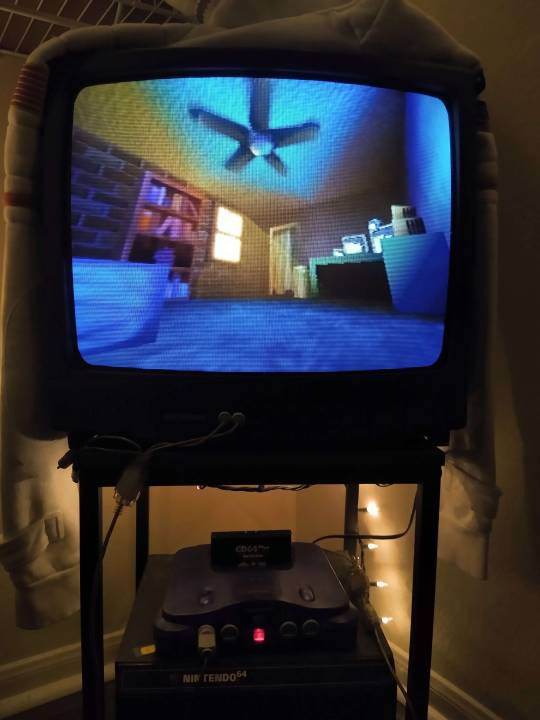
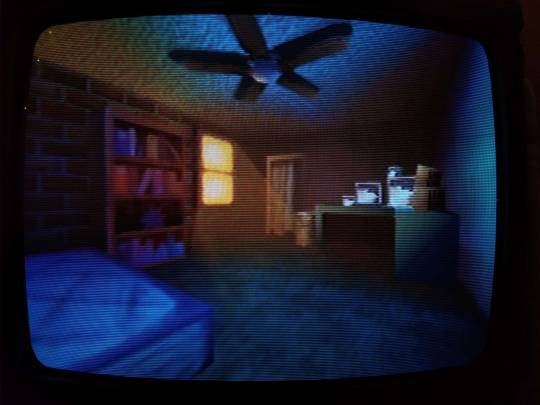
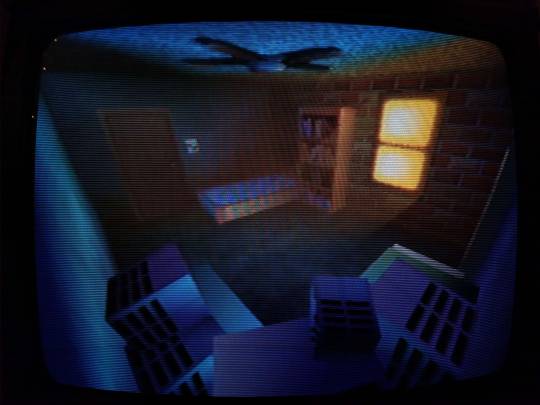
I cannot overstate just how fucking amazing this is.
Obviously this is not using Godot anymore, but an open source SDK for the N64 called Libdragon. The 3D support is still very much in active development, and it implements-- get this-- OpenGL 1.1 under the hood. What the heck is this sorcery...
UH OH, YOU'VE BEEN TRAPPED IN THE GEEK ZONE! NO ESCAPE NO ESCAPE NO ESCAPE EHUEHUHEUHEUHEUHUEH While there is a gltf importer for models, I didn't want to put my faith in a kinda buggy importer with an already (in my experience) kinda buggy model format. I wanted more control over how my mesh data is stored in memory, and how it gets drawn. So instead I opted for a more direct solution: converting every vertex of every triangle of every object in the scene by fucking hand.
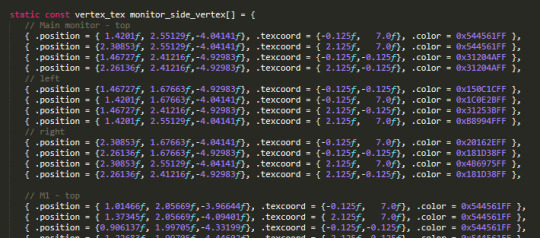
THERE ARE NEARLY NINE HUNDRED LINES OF THIS SHIT. THIS TOOK ME MONTHS. And these are just the vertices. I had to figure out triangle drawing PER VERTEX. You have to construct each triangle counterclockwise in order for the front of the face to be, well, the front. In addition, starting the next tri with the last vertex of the previous tri is the most efficient, so I plotted out so many diagrams to determine how to most efficiently draw each mesh. And god the TEXTURES. When I painted the textures for this scene originally, I went no larger than 64 x 64 pixels for each. The N64 has an infamously minuscule texture cache of 4kb, and while there were some different formats to try and make the most of it, I previously understood this resolution to be the maximum. Guess what? I was wrong! You can go higher. Tall textures, such as the closet and hallway doors, were stored as 32 x 64 in Godot. On the actual N64, however, I chose the CI4 texture format, aka 4-bit color index. I can choose a palette of 16 colors, and in doing so bump it up to 48 x 84.
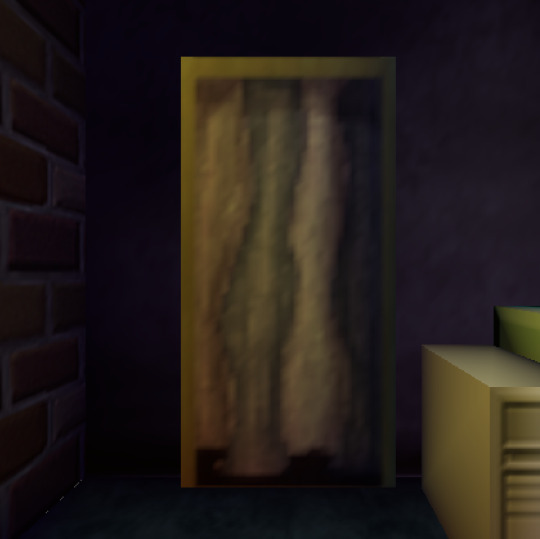
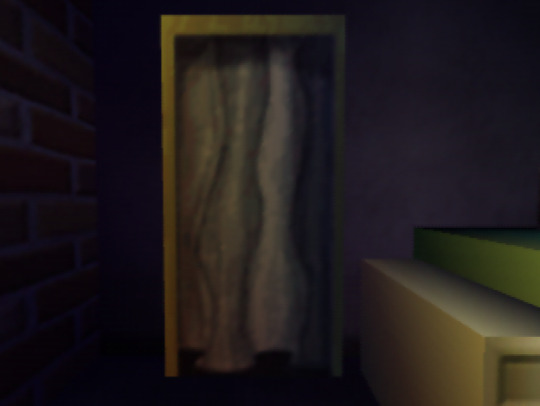
On the left, the original texture in Godot at 32 x 64px. On the right, an updated texture on the N64 at 48 x 84px. Latter screenshot taken in the Ares emulator.
The window, previously the same smaller size, is now a full 64 x 64 CI4 texture mirrored once vertically. Why I didn't think of this previously in Godot I do not know lol
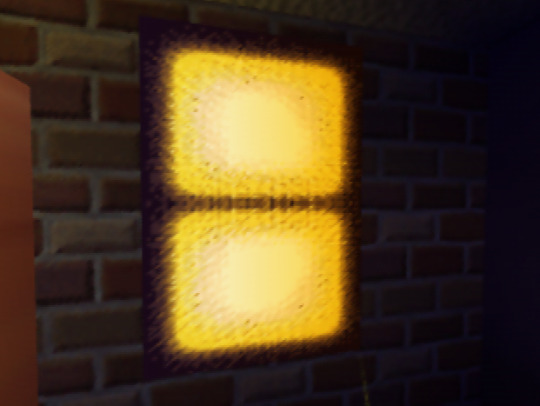
Similarly, the sides of the monitors in the room? A single 32 x 8 CI4 texture. The N64 does a neat thing where you can specify the number of times a texture repeats or mirrors on each axis, and clip it afterwards. So I draw a single vent in the texture, mirror it twice horizontally and 4 times vertically, adjusting the texture coordinates so the vents sit toward the back of the monitor.


The bookshelf actually had to be split up into two textures for the top and bottom halves. Due to the colorful array of books on display, a 16 color palette wasn't enough to show it all cleanly. So instead these are two CI8 textures, an 8-bit color index so 256 colors per half!! At a slightly bumped up resolution of 42 x 42. You can now kind of sort of tell what the mysterious object on the 2nd shelf is. It's. It is a sea urchin y'all it is in the room of a character that literally goes by Urchin do ddo you get it n-
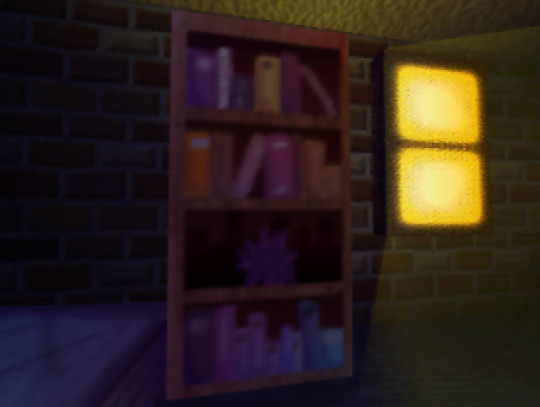

also hey do u notice anything coo,l about the color of the books on each shelf perhaps they also hjint at things about Urchin as a character teehee :3c I redid the ceiling texture anyways cause the old one was kind of garbage, (simple noise that somehow made the edges obvious when tiled). Not only is it still 64px, but it's now an I4 texture, aka 4-bit intensity. There's no color information here, it's simply a grayscale image that gets blended over the vertex color. So it's half the size in memory now! Similarly the ceiling fan shadow now has a texture on it (it was previously just a black polygon). The format is IA4, or 4-bit intensity alpha. 3 bits of intensity (b/w), 1 bit of alpha (transparency). It's super subtle but it now has some pleasing vertex colors that compliment the lighting in the room!

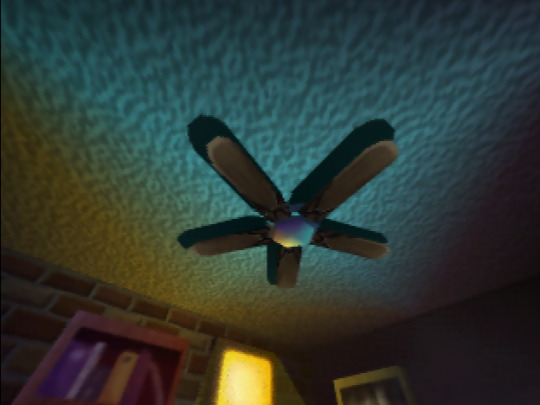
Left, Godot. Right, N64. All of the texture resolutions either stayed the same, or got BIGGER thanks to the different texture formats the N64 provides. Simply put:
THE SCENE LOOKS BETTER ON THE ACTUAL N64.
ALSO IT RUNS AT 60FPS. MOSTLY*. *It depends on the camera angle, as tried to order draw calls of everything in the scene to render as efficiently as I could for most common viewing angles. Even then there are STILL improvements I know I can make, particularly with disabling the Z-buffer for some parts of the room. And I still want to add more to the scene: ambient sounds, and if I can manage it, the particles of dust that swirl around the room. Optimization is wild, y'all. But more strikingly... fulfilling a childhood dream of making something that actually renders and works on the first video game console I ever played? Holy shit. Seeing this thing I made on this nearly thirty-year-old console, on this fuzzy CRT, is such a fucking trip. I will never tire of it.
46 notes
·
View notes
Text
Spacetop G1, World’s first Laptop that uses AR Glasses instead of a Display

A laptop that employs augmented reality glasses as a display was called the Spacetop G1 system, and it was shown to a thousand productivity pioneers by the tech firm Sightful last year.
The upgraded Gen 1 device removes the requirement for the user to stoop over a tiny screen when working remotely on a laptop by placing a 100-inch virtual display directly in their eyes.
In this blog, The TechRobot will showcase the World’s first AR laptop: Spacetop G1. So let us begin.
What is Spacetop G1?
Sightful’s Screenless Laptop, the Spacetop G1, combines a computer with comfortable, lightweight augmented reality glasses. Running on the device is SpaceOS, a spatial operating system with an emphasis on online operations intended for productivity.
The weight of the AR glasses is 85 grams, but the Vision Pro, depending on the Light Seal, weighs between 600 and 650 grams. The keyboard is bulkier compared to a MacBook Air or iPad Pro, measuring less than 12 inches in width and weighing three pounds.
Cost of AR Laptop
The Screenless Laptop, Spacetop G1 charges $1,700 and is just a keyboard with spectacles attached.
Spacetop G1 Specs
Spacetop G1, features a Qualcomm Snapdragon QCS8550 CPU, Kryo GPU, Adreno 740 AI, dual eNPU V3, 48 INT8, 12 FP16 TOPs, 16 GB LPDDR5, 128 GB UFS3.1 storage, and 8-hour battery life.
They have two OLED display screens, a 50° field of vision, a 90Hz refresh rate, and very crisp text rendering.
The glasses enable Wi-Fi, Bluetooth, 5G, and a 5MP camera. They also contain a microphone for use in online meetings.
Benefits of AR Laptops
1. Endless View
With Spacetop’s Virtual Desktop, you may get amusement and information without having to navigate around, making it a convenient substitute for real screen space. Although it’s not the only solution with this functionality, this one could be the easiest to use.
A standard keyboard and touchpad, Spacetop’s AR glasses, and a perhaps lower price tag might allow customers to enjoy endless screen areas without sacrificing functionality. For individuals who would rather have a more ordered workstation, this would be a time-saving alternative.
2. Absolute privacy
Multi-monitor laptop attachments should not be used in public areas due to the increased danger of uninvited eyes peeping at private information caused by an excessive number of physical displays. Although privacy screens are available on certain computers and monitors, they are limited to one monitor.
To solve this, Spacetop is a Screenless Laptop, letting the user see their screen alone until it is shared with others. But it also means that those standing close to the user can’t see the screen without their glasses.
3. Improved posture
Laptops’ screens are firmly attached to the keyboard, making them portable yet uncomfortable. Some people find relief from this neck pain by attaching a desktop monitor.
The screenless laptop, Spacetop, provides a more comfortable height and does away with the need for arms or ergonomic monitor supports. Due to this, laptops are a better choice for use at home or in the workplace.
4. Laser Focus
Spacetop G1 is an Augmented Reality (AR) device that reduces visual distractions so users can work productively and enjoy their free time. The apps it may utilize, including Windows or macOS-based software and limited gaming, are restricted by its Android-based operating system and mobile hardware.
Notwithstanding these drawbacks, Spacetop provides a more practical experience than a typical computer since it places all of the necessary components in front of and surrounding users. Instead of letting others decide for them, users may choose whether to allow virtual distractions to affect them.
Highlight – Introducing Travel Mode For Meta Quest Headsets
Best AR Glasses for Laptops
1. Apple AR Glasses
Apple plans to develop AR glasses that look like conventional spectacles with a built-in display. A prototype of the glasses has a thick, attractive frame and resembles high-end luxury sunglasses. With references to Project Starboard and reports of a glassOS, the prototype is anticipated to function on iOS 14.
Though it could take a few more years for a public release, rumors indicate that Apple has already started the second phase of development. The glasses will have the ability to add prescription lenses, gesture-controlled instructions that connect with the Apple Watch, and a true vision display on both lenses.
Possible capabilities include the ability to use virtual things in real-world settings, do activities without using a phone, and enable immersive phone conversations and remote collaboration software.
2. Meta Glasses
Rebranding Facebook to Meta, Mark Zuckerberg is concentrating on augmented reality glasses and headsets. The business plans to deliver Meta spectacles, a prototype of their augmented reality spectacles, in late 2024. The Project Nazare and Project Aria prototypes provide a fully functional augmented reality experience, with 3D visuals and an elegant design. It is anticipated that the Meta Glasses will include an immersive experience with radio, speakers, and cameras, a holographic display with built-in projectors, batteries, and sensors, and a broad field of vision. In 2024, the prototype is anticipated to be released.
3. Xreal Air 2 Ultra
The Air 2 Ultra glasses from Xreal are an improvement over the Air 2 model and are aimed at competing with Apple’s Vision Pro and Meta’s Quest 3 headsets. Complete positional tracking, a form factor akin to eyeglasses, and compatibility for immersive AR apps, TV viewing, and flat-screen gaming are all features of the Air 2 Ultra.
It has a 52-degree field of vision, 500 nits of brightness, two cameras for environmental mapping, hand tracking, and compatibility with Xreal’s Nebula AR environment.
Is AR safe for your eyes?
Prolonged use of AR might result in headaches, nausea, and straining of the eyes. This is a result of our eyes continually focusing on objects at different distances when using AR. This can cause pain and eye tiredness.
Conclusion
The future of laptops with AR like the Spacetop G1 marks a breakthrough in laptop technology by utilizing augmented reality to provide a 100-inch virtual display that improves user posture, productivity, and privacy.
The Spacetop G1 presents a new option for remote work by addressing typical ergonomic concerns associated with standard laptops by mixing AR glasses with a powerful computing machine and the SpaceOS operating system.
Despite several drawbacks associated with its Android-based operating system and the possibility of eye discomfort after extended usage, the Spacetop G1 breaks new ground in augmented reality technology by offering consumers a more useful and engaging experience.
#spacetop1#ar#vr#ar glasses#laptop#virtual reality#augmented reality#mark zuckerberg#elon musk#meta ai#facebook
6 notes
·
View notes
Text
🌐 Arweave: The Future of Permanent Decentralized Storage
As blockchain technology evolves, Arweave stands out as a revolutionary solution for permanent data storage. Unlike traditional storage methods, Arweave ensures your data remains secure, immutable, and accessible for generations through its Proof-of-Access (PoA) consensus mechanism.
🔹 Why Choose Arweave?
✅ Permanent Storage – Your data is stored forever on the Permaweb
✅ Decentralized Security – No single point of failure
✅ Eco-Friendly Consensus – Sustainable blockchain model
✅ Supports dApps & DeFi – Beyond just storage
💰 Powered by the AR Token With a capped supply of 66 million, the AR token fuels the network, incentivizing data storage while maintaining an efficient and scalable ecosystem.
📌 Bridging Ethereum to Arweave
Want to move your Ethereum assets to Arweave? Platforms like @rocketxexchange make it seamless:
1️⃣ Connect your wallet (MetaMask, Trust Wallet, etc.)
2️⃣ Select Ethereum as the source & Arweave as the destination
3️⃣ Enter the amount & your Arweave wallet address
4️⃣ Review details & confirm the transaction
5️⃣ Check your wallet – your assets are now on Arweave!
🔐 Top Wallets for AR Storage
✔ ArConnect – Noncustodial & browser-friendly
✔ Lightweight & open-source
✔ Ledger – Best for hardware security
With Arweave’s game-changing capabilities, the future of decentralized storage is here. Whether you're a developer, investor, or blockchain enthusiast, now is the time to explore the power of permanent data storage.
#Arweave #Blockchain #Crypto #DecentralizedStorage #Web3 #Ethereum #CryptoInvesting
Click on:
#crypto#crypto community#cryptocurency news#cryptocurrency#cryptocurreny trading#ethereum#binance#bitcoin#coinbase#crypto market#arweave
4 notes
·
View notes